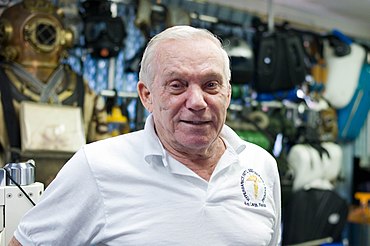


Richard Rutkowski is a pioneer in the fields of hyperbaric medicine, diving medicine and diver training, especially in relation to the use of breathing gases.



Richard Rutkowski is a pioneer in the fields of hyperbaric medicine, diving medicine and diver training, especially in relation to the use of breathing gases.
Rutkowski joined the US government service in 1950 and served during the Korean War. As a government civilian he served until 1970 when NOAA was established. He worked at NOAA from 1970 until 1985 as Deputy Diving Coordinator, Director of the NOAA Miami Hyperbaric Facility and Director of NOAA Diver Training. While at NOAA he founded the NOAA Diving/Hyperbaric Training and Diver Treatment Facility in 1973, and served as a director until 1985. He also served as co-director for the Physician's Diving and Hyperbaric Medical Training Program. During this time, hundreds of physicians have completed this program and are presently serving as directors and/or physicians for major hyperbaric facilities in the US and abroad.
Rutkowski is a NOAA aquanaut, having undergone saturation many times. [1]
After retiring from NOAA, Rutkowski formed Hyperbaric International, Inc. He is also past president of the Undersea and Hyperbaric Medical Society, Gulf Coast Chapter. [1]
In the 1970s Rutkowski taught the first diving emergency and accident management courses, including stressing the importance of oxygen use at the dive site by non-professionals. In 1978, he wrote and published the first diving accident management manual, setting the Divers Alert Network standard. [1]
In 1985, Rutkowski began the introduction and popularization of nitrox use within the recreational diving community. [2] This opened up some controversy between divers and the scientific community at the time. [3] Rutkowski founded several organizations to focus on diver training and safety including American Nitrox Divers International (ANDI), the International Association of Nitrox Divers (IAND) - which later became known as the International Association of Nitrox and Technical Divers (IANTD) - and the Undersea Research Foundation (URF).
According to a March 2004 edition of Rodale's Scuba Diving magazine, "In the process of overcoming the negative hype surrounding oxygen-enriched air, he also gave us one of his other significant contributions to diving—a now famous quote—"Science Always Wins Over Bullshit."
His publications include Instructor/Student Guide for the Use of Nitrogen-Oxygen Mixtures as a Divers' Breathing Gas, The Complete Guide to Nitrox Diving, Introduction to Nitrox Diving, Instructor/Student Guide for the Use of Breathing Gases During Hyperbaric Exposures, and Mixing/Blending for Nitrox and Trimix . He has also been a contributor and editor of the NOAA Diving Manual and training films. [1] He currently teaches a course titled "Advanced Diving / Hyperbaric Medical Team Training Program with Chamber Operations", which takes place monthly in Key Largo, FL. [4]
Mr Rutkowski, known to most as "Hyper-Dick", is known for holding court most afternoons from a table at Sharkeys in the Port Largo subdivision, an area of Key Largo. Rutkowski in 2016 moved his Hyperbarics International operation and gear collection to an office complex at mile marker 98.8 in Key Largo.
Honors and awards that Dick Rutkowski has received include:
Nitrox refers to any gas mixture composed of nitrogen and oxygen. This includes atmospheric air, which is approximately 78% nitrogen, 21% oxygen, and 1% other gases, primarily argon. In the usual application, underwater diving, nitrox is normally distinguished from air and handled differently. The most common use of nitrox mixtures containing oxygen in higher proportions than atmospheric air is in scuba diving, where the reduced partial pressure of nitrogen is advantageous in reducing nitrogen uptake in the body's tissues, thereby extending the practicable underwater dive time by reducing the decompression requirement, or reducing the risk of decompression sickness.

Narcosis while diving is a reversible alteration in consciousness that occurs while diving at depth. It is caused by the anesthetic effect of certain gases at high pressure. The Greek word νάρκωσις (narkōsis), "the act of making numb", is derived from νάρκη (narkē), "numbness, torpor", a term used by Homer and Hippocrates. Narcosis produces a state similar to drunkenness, or nitrous oxide inhalation. It can occur during shallow dives, but does not usually become noticeable at depths less than 30 meters (100 ft).

Trimix is a breathing gas consisting of oxygen, helium and nitrogen and is used in deep commercial diving, during the deep phase of dives carried out using technical diving techniques, and in advanced recreational diving.

Technical diving is scuba diving that exceeds the agency-specified limits of recreational diving for non-professional purposes. Technical diving may expose the diver to hazards beyond those normally associated with recreational diving, and to a greater risk of serious injury or death. The risk may be reduced by appropriate skills, knowledge and experience, and by using suitable equipment and procedures. The skills may be developed through appropriate specialised training and experience. The equipment often involves breathing gases other than air or standard nitrox mixtures, and multiple gas sources.

The International Association of Nitrox and Technical Divers (IANTD) is a scuba diving organization concerned with certification and training in recreational diving, technical diving, cave diving, wreck diving, rebreather diving and diver leadership. Originally formed as the International Association of Nitrox Divers in 1985 by Dick Rutkowski it pioneered the introduction of Enriched Air Nitrox diving to the recreational diving community, before its name change in 1992 to reflect the more "technical" diving courses it had begun to teach. The European Association of Technical Divers (EATD) became part of IANTD in 1993.
The National Association of Underwater Instructors is a non-profit association of scuba instructors. It primarily serves as a recreational dive certification and membership organization established to provide international diver standards and education programs. The agency was founded in 1960 by Albert Tillman and Neal Hess. NAUI is headquartered in the Tampa, Florida area with dive and member instructors, resorts, stores, service and training centers, located around the world.
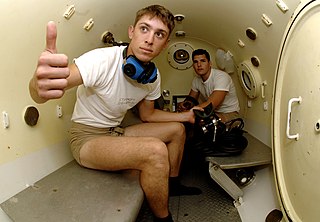
Diving medicine, also called undersea and hyperbaric medicine (UHB), is the diagnosis, treatment and prevention of conditions caused by humans entering the undersea environment. It includes the effects on the body of pressure on gases, the diagnosis and treatment of conditions caused by marine hazards and how relationships of a diver's fitness to dive affect a diver's safety. Diving medical practitioners are also expected to be competent in the examination of divers and potential divers to determine fitness to dive.

Scuba diving is a mode of underwater diving whereby divers use breathing equipment that is completely independent of a surface air supply. The name "scuba", an acronym for "Self-Contained Underwater Breathing Apparatus", was coined by Christian J. Lambertsen in a patent submitted in 1952. Scuba divers carry their own source of breathing gas, usually compressed air, affording them greater independence and movement than surface-supplied divers, and more time underwater than free divers. Although the use of compressed air is common, a gas blend with a higher oxygen content, known as enriched air or nitrox, has become popular due to the reduced nitrogen intake during long and/or repetitive dives. Also, breathing gas diluted with helium may be used to reduce the likelihood and effects of nitrogen narcosis during deeper dives.

Underwater diving, as a human activity, is the practice of descending below the water's surface to interact with the environment. It is also often referred to as diving, an ambiguous term with several possible meanings, depending on context. Immersion in water and exposure to high ambient pressure have physiological effects that limit the depths and duration possible in ambient pressure diving. Humans are not physiologically and anatomically well adapted to the environmental conditions of diving, and various equipment has been developed to extend the depth and duration of human dives, and allow different types of work to be done.
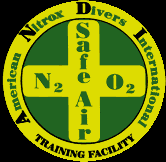
American Nitrox Divers International was founded by Ed Betts and Dick Rutkowski in 1988.
The World Recreational Scuba Training Council (WRSTC) was founded in 1999 and is dedicated to creating minimum recreational diving training standards for the various scuba diving certification agencies across the world. The WRSTC restricts its membership to national or regional councils. These councils consist of individual training organizations who collectively represent at least 50% of the annual diver certifications in the member council's country or region. A national council is referred to as a RSTC.
Master Scuba Diver (MSD) is a scuba diving certification or recognition level offered by several North American diver training agencies, such as the National Association of Underwater Instructors (NAUI), the Professional Association of Diving Instructors (PADI), Scuba Diving International (SDI), and Scuba Schools International (SSI). Other agencies offer similar programs under other names, such as "Elite Diver". Each of these agencies touts their program at this level as the highest, non-leadership program.

Tom Mount was an American pioneering cave diver and technical diver.
"Captain" Billy Deans is a pioneering wreck and technical diver. "Captain" is the nickname which is widely applied to Billy Deans, however he is a US Coast Guard-rated captain up to 100 tons.

Bret Clifton Gilliam is a pioneering technical diver. He is most famous as the founder of the certification agency Technical Diving International, and as the one time holder of the world record for deep diving on air. He is also one of diving's most popular writers. Gilliam is the author or coauthor of 72 books, over 1500 feature magazine articles, and over 100 magazine cover photos. In his diving career he has logged over 19,000 dives since 1959.
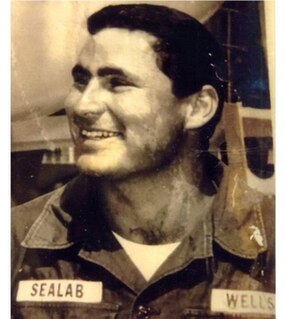
John Morgan Wells was a marine biologist, and physiologist involved in the development of decompression systems for deep diving, and the use of nitrox as a breathing gas for diving. He is known for developing the widely used NOAA Nitrox I and II mixtures and their decompression tables in the late 1970s, the deep diving mixture of oxygen, helium, and nitrogen known as NOAA Trimix I, for research in undersea habitats, where divers live and work under pressure for extended periods, and for training diving physicians and medical technicians in hyperbaric medicine.
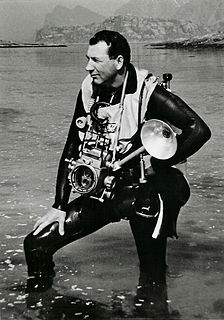
The history of scuba diving is closely linked with the history of the equipment. By the turn of the twentieth century, two basic architectures for underwater breathing apparatus had been pioneered; open-circuit surface supplied equipment where the diver's exhaled gas is vented directly into the water, and closed-circuit breathing apparatus where the diver's carbon dioxide is filtered from the exhaled breathing gas, which is then recirculated, and more gas added to replenish the oxygen content. Closed circuit equipment was more easily adapted to scuba in the absence of reliable, portable, and economical high pressure gas storage vessels. By the mid-twentieth century, high pressure cylinders were available and two systems for scuba had emerged: open-circuit scuba where the diver's exhaled breath is vented directly into the water, and closed-circuit scuba where the carbon dioxide is removed from the diver's exhaled breath which has oxygen added and is recirculated. Oxygen rebreathers are severely depth limited due to oxygen toxicity risk, which increases with depth, and the available systems for mixed gas rebreathers were fairly bulky and designed for use with diving helmets. The first commercially practical scuba rebreather was designed and built by the diving engineer Henry Fleuss in 1878, while working for Siebe Gorman in London. His self contained breathing apparatus consisted of a rubber mask connected to a breathing bag, with an estimated 50–60% oxygen supplied from a copper tank and carbon dioxide scrubbed by passing it through a bundle of rope yarn soaked in a solution of caustic potash. During the 1930s and all through World War II, the British, Italians and Germans developed and extensively used oxygen rebreathers to equip the first frogmen. In the U.S. Major Christian J. Lambertsen invented a free-swimming oxygen rebreather. In 1952 he patented a modification of his apparatus, this time named SCUBA, an acronym for "self-contained underwater breathing apparatus," which became the generic English word for autonomous breathing equipment for diving, and later for the activity using the equipment. After World War II, military frogmen continued to use rebreathers since they do not make bubbles which would give away the presence of the divers. The high percentage of oxygen used by these early rebreather systems limited the depth at which they could be used due to the risk of convulsions caused by acute oxygen toxicity.

The following outline is provided as an overview of and topical guide to underwater diving:

The following index is provided as an overview of and topical guide to underwater diving:
Diving support equipment is the equipment used to facilitate a diving operation. It is either not taken into the water during the dive, such as the gas panel and compressor, or is not integral to the actual diving, being there to make the dive easier or safer, such as a surface decompression chamber. Some equipment, like a diving stage, is not easily categorised as diving or support equipment, and may be considered as either.
{{cite journal}}: CS1 maint: unfit URL (link){{cite journal}}: CS1 maint: unfit URL (link)